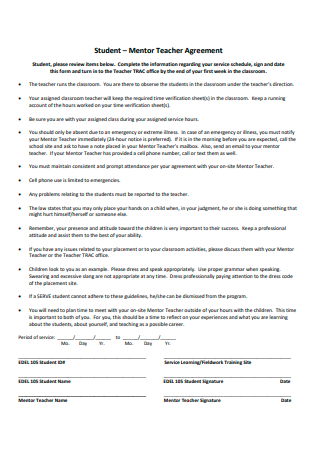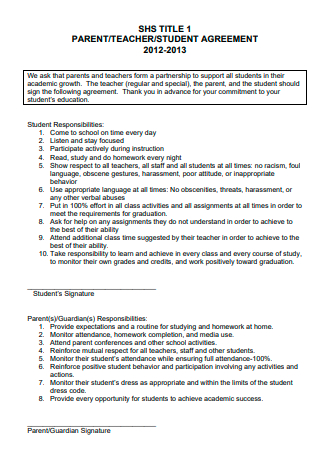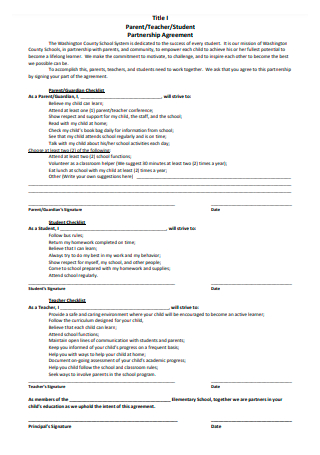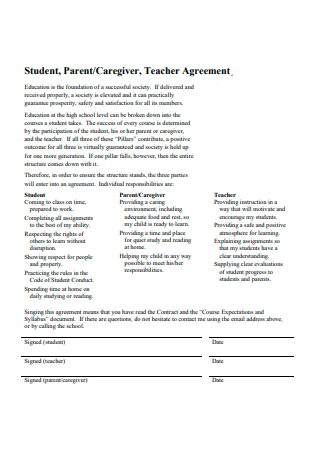3+ Sample Teacher Student Agreement
FREE Teacher Student Agreement s to Download
3+ Sample Teacher Student Agreement
What Is a Teacher Student Agreement?
What Are Some Tips Before Accepting the Agreement?
Elements of Teacher-Student Agreement
How to Write a Teacher Student Agreement
FAQs
Is Syllabus a Legal Document?
What Happens if One Party Refuses to do the Agreement?
Why Is it Important to Sign the Agreement?
What Other Things Should be Included Before Agreeing to the Agreement?
Is it Necessary for My Employer and Myself to Sign the Agreement in its Entirety, or Is it Sufficient to Merely Agree Verbally?
What More Items Should be Included in the Agreement Before it is Officially Signed?
Teacher Student Agreement forms are required in order to make the issues that have been agreed upon and addressed explicit, well-documented, and codified. For the purpose of avoiding having to start from the beginning (which would most likely be difficult), visit this website, read the remainder of this article, and browse among our available, ready-made but customizable templates that meet your project or form requirements. For your convenience, we have provided a number of Teacher-Student Agreement samples for you to review. Browse through the templates and make changes to the one that appeals to you most.
What Is a Teacher Student Agreement?
When it comes to teacher-student agreements, the emphasis is on the student’s needs and how to meet those needs. It is possible to do so in a classroom setting or in a school environment. This agreement is reached between the student, his or her parents, and the teacher in question. The agreement also includes the pledges or commitments made by all three parties, which may vary depending on what the student requires, what the teacher is capable of doing, and what the parents promise to do on their behalf. Additionally, this sort of agreement is legally binding and can only be completed if all three parties have agreed to carry out the conditions of the agreement that they have discussed during the discussion of terms. The significance of completing a teacher-student agreement is to ensure that what has been agreed upon by both sides will be carried out as agreed. This is done in order to ensure that the needs of the other party are also taken into consideration. This agreement is a formal mechanism for the student, the teacher, and the parent to convey their requirements to one another. Other agreement templates are available on our website, and you can use them whenever you need them. They are as follows: Agreements for employee equipment, vendor purchase agreements, vendor merchandise agreements, vendor service agreements, training services agreements, teacher employment agreements, workshop service agreements, university contracts, student teaching agreements, product sales agreements, farmland lease agreements, and other similar agreements are available. This post will not only provide you with templates but will also provide you with important information that you need to know in order to complete your agreement.
What Are Some Tips Before Accepting the Agreement?
It is understandable that we are overjoyed with the prospect of finally being hired. As a result, reaching an agreement would be a piece of cake. However, there are a few things you should consider before entering into any legally binding deal with anyone. Here are some suggestions for things you can do before signing an employment contract.
1. Remember to Thoroughly Read Everything in the Agreement
It is essential that you carefully read everything in the agreement. Regardless of how long the document is, do not scan or skim through it. When scanning over a document, there is a good risk that you will miss a crucial element that is contained inside it. Even if there is a potential that the agreement will be lengthy, make sure to carefully examine every single element.
2. Inquire About the Agreement/Ask for Clarifications
If you have any questions or concerns concerning the agreement, do not hesitate to ask for clarification or to ask additional questions. Your employer is more than glad to go over the specifics with you on the phone. In addition, asking questions demonstrates that you are interested in fully understanding the terms and conditions of the arrangement with which you are dealing.
3. Maintaining Track of How and What Was Discussed Is Difficult
Make certain that what they say is reflected in the agreement. However, if you recall some of them, go out and look for them. The next piece of advice I can give you is to talk about it.
4. Talk About It
Talk about the arrangement with your new employer. They are more than willing to talk about it and come up with a program that both parties can agree on. Salary receipts, working environment, vacation time, and other topics are all fair game for discussion.
5. Make Certain that the Information You Are Submitting Is Accurate
This is especially crucial because the agreement is legally enforceable. All of the information that has been submitted should be accurate.
Elements of Teacher-Student Agreement
In order to attain academic success in a course, students might voluntarily complete a learning contract, which describes the actions they promise to perform in order to do well in the course. It is necessary for the student, the instructor, and (optionally) the parent sign this contract. But the benefits of all such agreements are that they provide academic structure and support, motivate struggling learners by requiring them to publicly pledge to engage in specific, positive study and learning behaviors, and serve as a vehicle for bringing teachers and students to consensus on what course goals are important and how to achieve them. When the student and instructor meet, the learning contract is normally finalized. It is possible for the parent to participate in middle and high school. Despite the fact that there are numerous different variations on the learning contract, they frequently include the following components:
How to Write a Teacher Student Agreement
You might believe that putting together a teacher-student agreement will be a difficult endeavor. This may or may not be dependent on what you wish to achieve. For most teachers, a teacher-student agreement can be equated to a weekly lesson plan in terms of structure. Because this is where you will be strategizing about how you will assist the learner and how they will satisfy their own needs. This, however, differs from a lesson plan in that it continues until the student’s needs are addressed. The following pointers will assist you in understanding how to begin constructing a teacher-student contract agreement. However, the manner in which you execute your agreement will be determined by the needs of your student and the ability of the parent in question.
1. Your Objectives Should Be Stated
Provide a description of the objectives. What do you hope to accomplish this year? What are your long-term objectives that will also meet the needs of your students? Ensure that all of your objectives are written down and that they at the very least address the requirements and goals of your students.
2. The Promising Signs
According to the agreement, this is the teacher’s opportunity to make a decision that they believe will benefit the student. For kids, this is also an opportunity to jot down any pledges or goals that they have set for themselves in the future. The same is true for the parents of the students who attend the school. Each partner is required to write down a promise that they intend to keep.
3. Put Your Signature on It
Each member of the party is required to sign the paper after each of the aims, objectives, and commitments has been established. Demonstration that they are committed to achieving their goal. Once again, this is to identify the requirements of the pupil.
4. Draw Attention to Your Responsibilities
Each stakeholder must be aware of the duties that they must fulfill in order to attain the objectives. If one of the parties fails to fulfill their obligations or refuses to do so, the entire agreement may come crashing down. Because it is a form of promise, as well as a document that proves it.
5. Maintain Confidentiality
Nobody other than the people who have accepted the document’s terms is permitted to read it. The purpose of doing so is also to reassure the student and his or her parents that all they have written is completely confidential.
Having this document may prove to be a difficult chore for you, especially if you are creating it from fresh because it must take into consideration a large number of laws that must be in compliance with the law. If you want to avoid this, you should take advantage of the resources available on the internet, which will make your work simple, convenient, and high-quality.
FAQs
Is Syllabus a Legal Document?
The concept of a syllabus as a “good faith” agreement would be violated by changes to syllabi that are punishive to students after a course has begun, even though syllabuses are not legally binding in most cases. According to the court’s decision in this instance, however, a syllabus did not form a legally binding contract.
What Happens if One Party Refuses to do the Agreement?
If one side fails to uphold their end of the contract, the entire agreement is rendered moot and meaningless.
Why Is it Important to Sign the Agreement?
It demonstrates that you are aware of your responsibilities and that you have freely committed to do what you are expected to be doing by signing the agreement.
What Other Things Should be Included Before Agreeing to the Agreement?
You have the right to inquire about your income in addition to debating and asking questions. If it turns out that they did not include the amount in the agreement, you have the right to raise it as a point of contention. As an employee, you have the right to exercise your rights. You have a right to know how much money you will be making on a regular basis.
Is it Necessary for My Employer and Myself to Sign the Agreement in its Entirety, or Is it Sufficient to Merely Agree Verbally?
The agreement must be signed by both you and your employer. As legally binding as it is, it just affirms that you and your partner are on the same page and that you both agree on the points that have been discussed. Signing it merely signifies that you understand and accept your position as an employee in your employer’s organization.
What More Items Should be Included in the Agreement Before it is Officially Signed?
You have the right to inquire about your income in addition to debating and asking questions. If it turns out that they did not include the amount in the agreement, you have the right to raise it as a point of contention. As an employee, you have the right to exercise your rights. You have a right to know how much money you will be making on a regular basis.
When drafting a contract such as a teacher-student agreement, it is important to discuss if all three parties are willing to work together to complete the contract. Moreover, it should be indicated that everything that has been promised or discussed should be carried out so long as the party is capable of attaining it.




